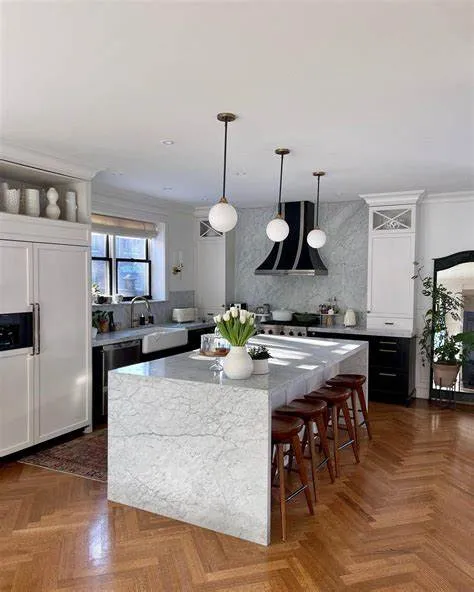A marble slab is more than just a piece of natural stone—it’s the result of a meticulous process involving millions of years of geological formation and modern human craftsmanship. Whether destined for a marble slab countertop, marble slab for kitchen, or decorative marble slab backsplash, each slab begins deep within the earth.
In this article, you’ll learn how marble slabs are made, from quarrying and cutting to finishing and installation. We’ll also explore the different types of marble slab, how they compare to alternatives like granite, and how to ensure you’re selecting the best marble slab for your needs.
Curious about the basics? What is a marble slab?

Step 1: Where Marble Slabs Begin – Geological Formation
Marble originates as limestone, undergoing intense heat and pressure over millions of years to recrystallize into a dense, veined material. This transformation is what gives natural marble slab its signature patterns and colors.
Key characteristics:
- Varied marble slab colors – from classic white marble slab to black, green, and Calacatta or Carrara marble slab
- Available in imported marble slab and local marble slab varieties

Step 2: Marble Quarrying – Extraction from the Earth
The process of making a marble slab starts in a quarry. Large blocks of raw marble are extracted using techniques like:
- Wire saws
- Diamond-tipped blades
- Explosives (for large-scale removal)
These massive blocks can weigh several tons. Transportation is a key concern due to the sheer marble slab weight involved.
Need help later? Here’s how to transport marble slab safely.
Step 3: Marble Slab Fabrication – Cutting the Blocks
Once the marble blocks reach a processing facility, they are cut into slabs. This process includes:
Primary Cutting
- Gang saws or block cutters slice the block into marble slab thicknesses (usually 2cm or 3cm)
Surface Finishing
- Polished marble slab: Smooth, glossy, high-reflective finish
- Honed marble slab: Matte, slip-resistant, great for floors
- Textured finishes: Sandblasted or brushed for rustic looks
Drying and Resin Filling
Tiny fissures and pores are filled with epoxy resin, which is hardened and polished.
Looking for ways to use remnant pieces? Read What to Do with Leftover Marble Slab?
Step 4: Quality Checks and Packaging
Before distribution, every marble slab is inspected for:
- Vein uniformity
- Surface imperfections
- Crack integrity
They are then measured and labeled for:
- Marble slab size (typically 100–120″ long × 55–65″ wide)
- Marble slab weight (up to 1,000 lbs depending on thickness)
These slabs are carefully packaged in wooden crates and secured for transport to marble slab suppliers or showrooms.
Step 5: Installation in Homes and Commercial Projects
When it reaches the end user, your slab may be cut further during marble slab installation into:
- Countertops
- Vanity tops
- Backsplashes
- Shower walls
- Flooring
Installers use specialized tools for marble slab cutting, polishing, edging, and sealing.
Want to prep food on your marble countertop? Here’s How to Use a Marble Slab as a Food Prep Surface
Types of Marble Slabs and Their Finishes
| Type | Features |
|---|---|
| Polished | High-gloss, elegant, stain-prone |
| Honed | Matte, scratch-resistant |
| Brushed/Sandblasted | Rustic, textured look |
Popular styles include:
- Carrara marble slab (Italy): Soft grey veining
- Calacatta marble slab: Bold, dramatic patterns
- Green marble slab: Earthy and exotic
- Engineered marble slab: Made with marble chips + resin
Key Considerations Before Choosing or Making a Marble Slab
1. Marble Slab Cost and Price
Marble pricing varies by origin, finish, and thickness. Average costs:
- Basic slabs: $40–$60/sq ft
- Premium/imported: $100–$200+/sq ft
2. Marble Slab Maintenance
- Regular sealing is essential
- Avoid acidic cleaners
- Wipe spills promptly
3. Marble Slab Durability
- Softer than granite
- Can scratch, etch, or chip without care
- More suited to low-traffic areas unless sealed well
Compare with granite: How to Edge Granite Countertops?
Marble Slab Use Cases
✔ Kitchen Countertops
Cool to the touch, great for baking and prep
✔ Bathrooms
Elegant, luxurious aesthetic
✔ Flooring and Wall Cladding
Creates seamless luxury in open spaces
✔ Fireplaces & Backsplashes
Easy to clean, timeless appearance
Explore ideas for food-safe use:
👉 How to Use Marble Slab for Food Prep
How to Customize Your Marble Slab
Many suppliers offer:
- Marble slab edge profiles: Eased, beveled, ogee
- Custom cutting: Templates for kitchen or bath layouts
- Finishes and sealing options
Calculate materials efficiently with:
👉 How to Figure Square Footage for Granite Countertops
Final Thoughts
Creating a marble slab is a blend of natural beauty and human precision. From quarrying to sealing, every step affects the slab’s final appearance and performance. Whether you’re choosing one for your home or simply curious about the fabrication journey, understanding how marble slabs are made gives you a greater appreciation for this timeless material.
When selected and maintained properly, a marble slab offers durability, luxury, and long-term value for any space.

